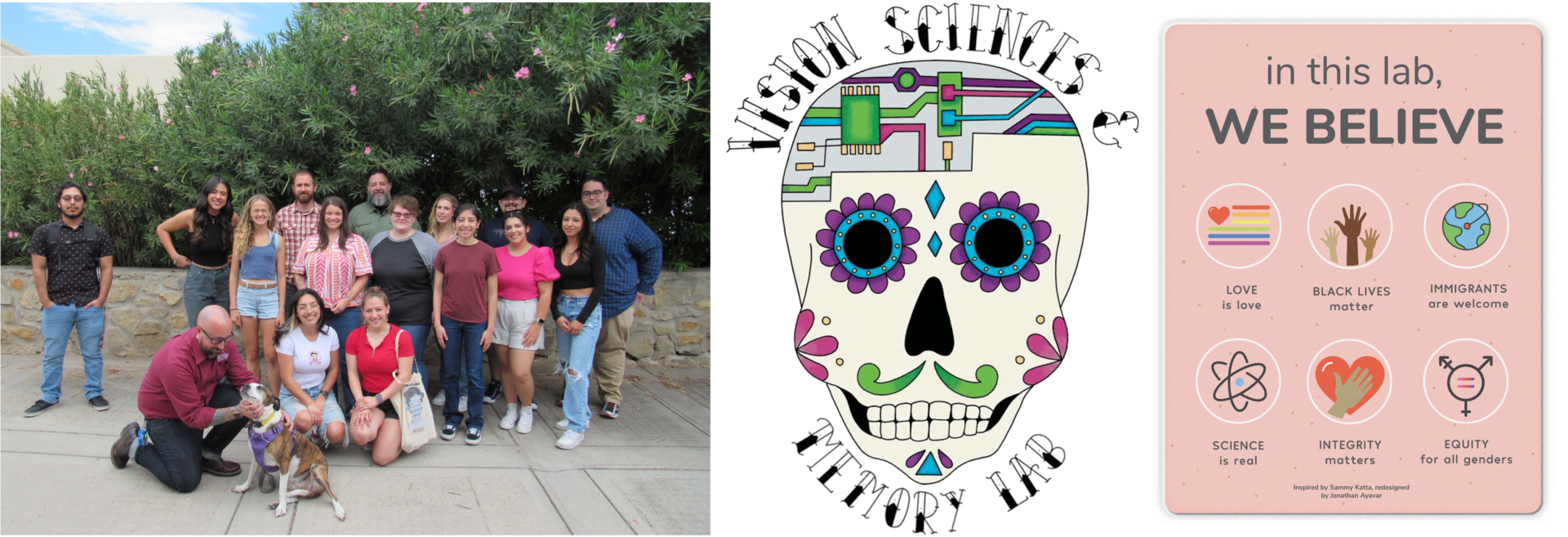
Hello, and welcome to my website. I am the Associate Dean for Research in the NMSU College of Health, Education, and Social Transformation (HEST). I am also a Professor with joint appointments in the Psychology Department and Kinesiology Department. I am the director of the Vision Sciences and Memory Laboratory in the Psychology Department, and co-director and co-founder (with Dr. Phillip Post) of the multi-disciplinary Addison Care Virtual and Augmented Reality Laboratory. Outside of NMSU, I am an Associate Editor (for the second time) at the journal Attention, Perception & Psychophysics. And I completed a 2-year rotation as a Program Director at the National Science Foundation in the Perception, Action, and Cognition Program and the Cognitive Neuroscience Program of the Division of Behavioral and Cognitive Sciences (Social, Behavioral, and Economic Sciences Directorate).
My research interests fall under the broad heading of visual cognition, including research into visual attention and memory, and computational models of both. My other research interests include (but are not limited to): development of alternative methods for collecting similarity data (e.g., for use in multidimensional scaling models), similarity as a psychological construct, and the development of new methodologies, research tools (e.g., software, databases), and tutorials.
My primary work focuses on memory and attention, with an emphasis on human visual processing. In my research, I employ converging techniques; specifically, I combine standard behavioral measurements (e.g., reaction time, similarity ratings) with more sensitive experimental techniques (e.g., eyetracking, tDCS), physiological indexes (e.g., pupillometry, heart rate), advanced statistical procedures (e.g., multidimensional scaling), virtual reality, and computational modeling. My immediate goals involve conducting theory-driven experiments that investigate decision-making in visual search, with the long-term aim of establishing computational models of the underlying cognitive processes. This theoretical aim is coupled with more applied goals, in particular learning how to alleviate problems that plague professional visual searchers, such as medical and security screeners, and search and rescue personnel.
In my lab in the Psychology Department, we have two state of the art eye-trackers, several banks of testing computers, and the resources to collect data from undergraduates at NMSU and from members of the public. We also employ touch screen monitors, virtual reality headsets, mobile eye-tracking, and transcranial direct current stimulation. The Addison Care Virtual Reality and Augmented Reality lab is a separate entity. It is a nearly 1000 square foot space equipped with multiple state-of-the-art virtual reality headsets (including one with embedded eye-tracking), computing stations, full lab tracking capability (to allow the VR users a great degree of movement in space), and the capacity to do augmented reality via green screen/floors.
I currently have five graduate students working under my mentorship (see the People tab for current lab members and the alumni), one post-doctoral researcher, as well as undergraduate research scholars and a visiting associate. My research is highly collaborative; I have collaborations within NMSU (both inside and outside of the Psychology department), in institutions around the US (e.g., Harvard Medical School, Arizona State University), and several abroad (e.g., the University of Southampton, the University of Sussex). I regularly publish my work in peer-reviewed journals and present at conferences as much as my schedule allows.
Additionally, I am also the Director of the Discovery Scholars Program. I regularly provide service to the scientific community. I am a reviewer for a great many different scientific peer-reviewed outlets and funding agencies, and I recently finished a four year term as Associate Editor at Attention, Perception & Psychophysics and started a new term at the journal as soon as my rotation at the NSF ended. I contribute to popular science magazines (e.g., Scientific American Mind) and general science outlets (e.g., Frontiers for Young Minds; see here for a story on Nature Index about this), I was twice a co-organizer for an international psychology conference (the Object Perception, Attention and Memory meeting) and serve as the Treasurer for them currently, and I make a concerted effort to share my work with other researchers. This involves the creation of databases that can be used in experimental psychology, and the free sharing of many of my software programs.
If you are interested in collaborative research, or in becoming a graduate student or research assistant in my lab, please feel free to contact me via email: mhout@nmsu.edu.


